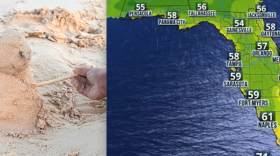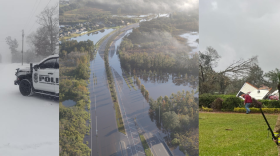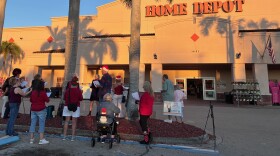The Alliance for the Arts in Fort Myers has issued a call to artists for its September exhibition titled “Storm Stories.” The call asks artists to encapsulate their experiences during and after Hurricane Ian in two and three dimensional works of art.
“’Storm Stories’ is a project centered on community healing,” says Gallery Manager Emily Radomski, sharing the exhibition’s rationale. “We really wanted to find a way for people to process their experiences after the storm — basically anything documenting their experience during or after the storm. It can be any medium as long as it’s an original piece, not a print. And it has to be smaller than five feet in any direction.”
In the past year, Florida and its Gulf Coast and Caribbean neighbors have weathered earthquakes, hurricanes, floods and drought, all amidst a global pandemic. Artists have helped disaster-impacted communities move forward, rebuild, and prepare for the next crisis. The Alliance hopes that “Storm Stories” will do likewise.
The exhibition includes both an oral and written component.
“For the oral history side of it, we’ve been collecting voicemails,” Radomski notes. “People could call and leave a voicemail just documenting their experience or what happened to them during and after the storm, and we’ve been collecting them since late October or November of last year.”
During that same time frame, the Alliance’s exhibition partner, the Gulf Coast Writers Association, has also been collecting written accounts provided by people impacted by Ian. There was no age or word limit, and submissions could be in prose or poetry.
“So they’ve compiled about 50 stories into a book documenting different people’s stories, and that will be available here during the month of September for sale, and they’ll be giving an author talk as well during the month with some of those contributors.”
As GCWA Program Director Mary Charles notes, both the written accounts and oral histories are now part of Hurricane Ian’s permanent record and lasting legacy.
According to Radomski, the idea for both the book and associated art exhibition evolved from a discussion that occurred at the Alliance’s first weekly staff meeting following their re-opening some three weeks after the storm.
“We all sat down and it was kind of just like a check-in, where we all just talked about what we had experienced, and I think it was really helpful for us to talk about it as a group and talk about what we had seen and what we had done, and everything. And so we thought maybe the community needs that as well.”
There’s a third component to September’s “Storm Stories” exhibition, and it comes to the community compliments of the Disaster in the Body Project conducted by the University of Florida’s Center for Arts, Migration and Entrepreneurship. According to Professor of Epidemiology Burton Singer, natural disasters and pandemics result in widespread toxic stress which can lead to negative health effects in an event’s aftermath.
“It’s basically about how the body holds trauma,” Radomski observes. “And so they’ll give a talk, a lecture, about trauma in the body and then they’ll lead visitors through some movements to help release some of the tension and the trauma that the body can hold.”
Artists interested in participating in the visual art component of “Storm Stories” have until 5 p.m. on August 7th to submit digital images of up to three works in any media, except giclees, that either use found objects and recycled materials collected after Ian or express their experiences during and after the storm. There is no entry fee although the show is juried to ensure theme.
A prospectus for the exhibition can be found on the Alliance’s website (provided below).
“The art exhibit will be up for the whole month. It will open on the first, but there will be no reception. We’re doing a closing reception on the anniversary of the storm on the 28th.”
Radomski adds that the Alliance has witnessed the healing power of art and is bringing “Storm Stories” in that spirit.
“We just hope this will be helpful for the community without re-opening wounds, I guess. We really want the concentration to be an outlet for the community to heal.”
MORE INFORMATION:
- The Alliance for the Arts is a nonprofit community visual and performing arts center located in the heart of Fort Myers, Florida. Since 1975, the Alliance has been committed to transforming lives and improving community through the arts. The Alliance campus and galleries are open to the public from 9 a.m. to 7 p.m. Tuesday through Friday, and from 9 a.m. to 1 p.m. on Saturdays. It’s 10-acre campus is located at 10091 McGregor Boulevard just south of Colonial Boulevard in Fort Myers. For more information, please call 239-939-2787, visit us at www.ArtInLee.org. You can also follow the Alliance on Facebook, Instagram and Twitter.
- Founded in 1995 and incorporated in 2004, the Gulf Coast Writers Association, Inc. (GCWA) provides a forum for fellowship, education, and information for writers. GCWA’s well-regarded annual writing contest draws a wide-range of authors. Based in Fort Myers, the organization attracts members from throughout Southwest Florida from Marco Island to Tampa. At monthly meetings, speakers and workshops offer expert advice on such topics as writing techniques, publishing, and marketing. Participants at these meetings also have the opportunity to read their works. The organization’s members include published as well as unpublished writers and professional editors, agents and publicists. The literary genres run the gamut from poetry, adult fiction and nonfiction to children’s and young adult, historical fiction, romance, mystery/thriller, memoir, essays and screenplay. Members include full-time writers as well as corporate professionals, teachers, and business owners, all still working or retired. GCWA’s website is gulfwriters.org.
- The deadline for written “Storm Stories” submissions closed May 15, 2023. However, the Alliance is still collecting oral histories. Some of the latter may appear on the walls of the gallery during the September exhibition.
- The juried exhibition in the Alliance’s main gallery will be on display September 1-30, 2023. The exhibition will culminate in a closing reception on the anniversary of Hurricane Ian’s landfall on September 28, 2023 from 5 to 7 p.m. This event will be in place of an opening reception and will include light refreshments.
- “At the Alliance for the Arts (AFTA), we believe in the healing power of art,” says Gallery Manager Emily Radomski. “In the aftermath of Hurricane Ian, we have seen a great need for healing in our community.”
- With respect to the University of Florida Trauma in the Body Project, new research, published in the Journal Psychoneuroendocrinology explores a concept known as allostatic load, which represents the price paid by the body for responding to repetitive and diverse forms of stressful experiences. It is based on the idea of allostasis, which is a process of physiological adaptation to acute stress that restores a condition of homeostasis in the face of challenges. Over time, cumulative exposure to stressful challenge leads to wear and tear on the body, accumulation of allostatic load, and an increased susceptibility to disease. Singer and his coauthors developed a framework that melds aspects of psychosocial and physiological allostatic load to estimate its burden in people affected by disasters and traumatic events. These estimates could be used to gauge the short- and long- term health effects of disasters, or to predict or mitigate prevention of specific illnesses or conditions. The framework could even be leveraged for use in an observing system focused upon post-disaster human health, the authors say.
- In 1936, German psychoanalyst Wilhelm Reich postulated that the body develops chronic muscular spasms in order to block the release of emotions such as anxiety, rage and sexual excitation. He termed this phenomenon as “muscular armouring” and developed a system of releasing these spasms through physical manipulation which concurrently released the associated repressed childhood memories giving rise to the blocked emotions.
- Ida Pauline Rolf similarly developed a system of soft tissue manipulation and movement education now called “Rolfing” that seeks to release trauma encapsulated in the body’s muscles, thereby returning the skeleton and musculature to proper, health-promoting alignment. [See also, Moshe Feldenkrais’s Awareness Through Movement system of physical exercise that aims to improve human functioning and overall health by increasing awareness through movement.]
- In the same way, the UF Trauma in the Body Project proposes certain movements as a way of releasing allostatis associated with events such as Hurricane Ian.
- “We’ll have availability during the month [of September] for people to come in and work with a massage therapist,” Radomski notes. “So I think we’re planning on having one day that’s dedicated to first responders to come and get a free massage and free meditation. And then we’ll have different ones available to different groups of people who went through a lot during that time.”
To read more stories about the arts in Southwest Florida visit Tom Hall's website: SWFL Art in the News.
Spotlight on the Arts for WGCU is funded in part by Naomi Bloom, Jay & Toshiko Tompkins, and Julie & Phil Wade.







